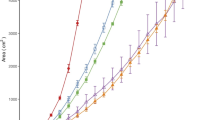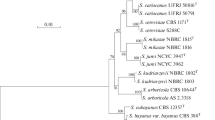Summary
Banding patterns of esterase isozymes in Aegilops triuncialis (2n = 28, genome formula CuCuCC) and its putative parental species, Ae. umbellulata (2n = 14, CuCu) and Ae. caudata (2n = 14, CC), were studied by the gel isoelectric focusing method using pH 6–8 carrier ampholite. Zymogram phenotypes of both parents were quite uniform. Seven zymogram phenotypes (designated as phenotypes 1 to 7) were found among the 260 strains of Ae. triuncialis examined. Of these phenotypes, phenotype 1 was identical to the zymogram phenotype produced by the ancestral species, Ae. umbellulata, and bands considered to have been derived from Ae. caudata were absent in this phenotype. Phenotype 3 had all bands of both parents. The other phenotypes differed greatly from phenotype 3. Therefore, phenotype 3 was considered to be most primitive of the 7 types, and the Ae. triuncialis strains which showed phenotype 3 to be the most primitive of the strains examined. If Ae. triuncialis originated as a hybrid between Ae. umbellulata and Ae. caudata, the zymogram phenotype must have been phenotype 3, in which the isozymes of both parental species are present. Whether the phenotypes other than type 3 were due to introgressive hybridization could not be verified, but they were considered in this article to be a consequence of a rearrangement of chromosomes.
Similar content being viewed by others
Literature
Eig, A. (1929): Monographisch-kritische Übersicht der Gattung Aegilops. Repertorium speciarum novarum regni vegetabilis Beihefte 55, 1–128
Kihara, H. (1940): Anwendung der Genomanalyse für die Systematik von Triticum und Aegilops. Jpn. J. Genet. 16, 309–320 (in Japanese)
Kihara, H. (1963): Interspecific relationship in Triticum and Aegilops. Seiken Ziho 15, 1–12
Kihara, H.; Kondo, N. (1943): Studies on amphidiploids of Aegilops caudate X Ae. umbellulata induced by colchicine. Seiken Ziho 2, 24–42 (in Japanese)
Kihara, H.; Yamashita, K.; Tanaka, M.; (1965): Morphological, physiological, genetical and cytological studies in Aegilops and Triticum collected from Pakistan, Afghanistan and Iran. Results of the KUSE to the Karakoram and Hindukush, 1955. 1, 1–118
Kondo, N. (1940): Colchicine treatment in Secale, Haynaldia and Aegilops. Plant and Animals 8, 69–70 (in Japanese)
Nakai, Y. (1972): Isozymes of Aegilops triuncialis and its parental species. Wheat Info. Serv. 33–34, 15–19
Nakai, Y. (1973): Isozyme variations in Aegilops and Triticum, II. Esterase and acid phosphatase isozymes studied by the gel isoelectrofocusing method. Seiken Ziho 24, 45–73
Nakai, Y.; Teramura, T.; Tsunewaki, K. (1969): Variation in esterase of Triticum and Aegilops analyzed by the gel isoelectrofocusing technique. Jpn. J. Genet. 44, 259–270 (in Japanese)
Nakai, Y.; Tsunewaki, K. (1971): Isozyme variations in Aegilops and Triticum, I. Esterase isozymes in Aegilops studied using the gel isoelectrofocusing method. Jpn. J. Genet. 46, 321–336
Sears, E.R. (1939): Amphidiploids in the Triticinae induced by colchicine. J. Hered. 30, 38–43
Zohary, D. (1965): Colonizer species in the wheat group. In: The Genetics of Colonizing Species (eds. Baker, H.G.; Stebbins, G.L.), pp. 403–423. New York: Acad. Press
Zohary, D.; Feldman, M. (1962): Hybridization between amphidiploids and the evolution of polyploids in the wheat (Aegilops-Triticum) group. Evolution 16, 44–61
Author information
Authors and Affiliations
Additional information
Communicated by R. Riley
Contribution from the Laboratory of Genetics, Faculty of Agriculture, Kyoto University No. 432
Rights and permissions
About this article
Cite this article
Nakai, Y. Origin and differentiation of Aegilops triuncialis L. as determined by esterase isozyme analysis. Theoret. Appl. Genetics 59, 169–175 (1981). https://doi.org/10.1007/BF00264972
Received:
Issue Date:
DOI: https://doi.org/10.1007/BF00264972




